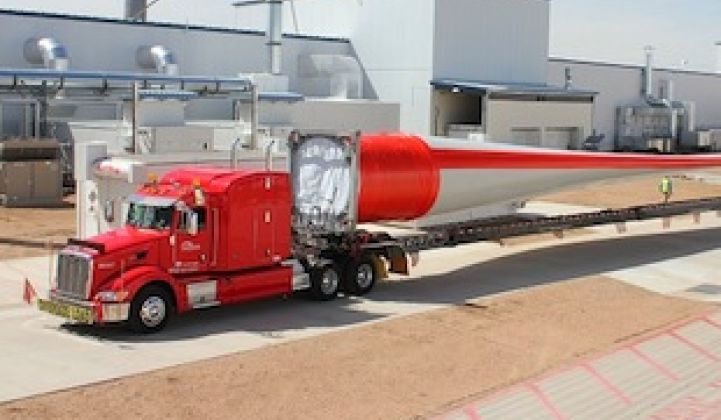How good is it in U.S. wind power manufacturing these days? This good: When Vestas announced its latest wind turbine orders this week, it included a link to the website of a staffing agency that is helping it hire hundreds of new employees at the Colorado factories were Vestas builds blades and nacelles.
The increasingly favorable economics of wind power are a factor in the trend, but the timing and intensity of the rush of new orders is being driven by the industry’s key federal subsidy, the 2.3-cents per kilowatt-hour production tax credit. Under the law, projects must be under development before the end of the year in order to qualify for the credit, which pays dividends for the first ten years of a wind farm’s operation.
This is a big change from last year. The PTC appeared doomed to history, causing the pipeline of new projects to dry up and prompting wind component manufacturers to lay off employees all over the country. Now the companies are gearing back up. In a press release this week announcing a 150-megawatt order from First Wind, Vestas wrote:
To meet customer demand, Vestas is adding more workers at three of its Colorado factories -- the blade factory in Windsor as well as the blade and nacelle factories in Brighton. Vestas is recruiting now and expects to add hundreds of production workers in the first half of 2014 in Windsor and Brighton, primarily at the two blade factories. Interested candidates can apply at ElwoodWindJobs.com.
On Friday, Reuters reported that Vestas set a company record for orders booked in a month in December, with 1,346 megawatts.
Jobs in the wind manufacturing sector look strong elsewhere, as well, thanks to huge orders like MidAmerican Energy’s contract with Siemens for 448 2.3-megawatt wind turbines to be used at five new Iowa wind power plants. That’s driving Siemens jobs in Fort Madison, Iowa, and Hutchinson, Kan., while tower maker Broadwind Energy, with plants in Wisconsin and Texas, also stands to benefit.
One key way that wind power developers can meet the requirement of being “under development” is to have incurred 5 percent of their costs by Jan. 1, 2014. Once they do that, the developers then have to make a “continuous effort” to complete the facility. That’s slightly fuzzy, but the Internal Revenue Service has said that if a facility is in service before the end of 2015, it will definitely meet the “continuous effort” requirement.
The fact that the PTC will expire at the end of the year obviously isn’t seen as as a traumatic event by the industry. There’s plenty of work on the books, and the industry will push during 2014 for a retroactive extension.
***
Editor's note: This article is reposted in its original form from EarthTechling. Author credit goes to Pete Danko.



